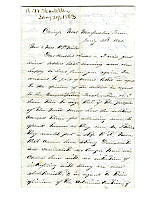Amos W. Hostetter to Owen P. Miles and Hannah Miles, Amos W. Hostetter Papers (Part 1 of 8)
This is a letter of First Lieutenant Amos W. Hostetter at Murfreesboro, Tennessee to Owen P. and Hannah Miles in Illinois, dated January 29, 1863. Hostetter was in the U.S. Army, a member of the 34th Illinois Infantry Regiment. He was later promoted to the rank of captain and died in 1864. The letter conveys Hostetter's views on slavery, the Emancipation Proclamation, and the administration's war policy. He forcefully presents a case for supporting the president's proclamation.
























